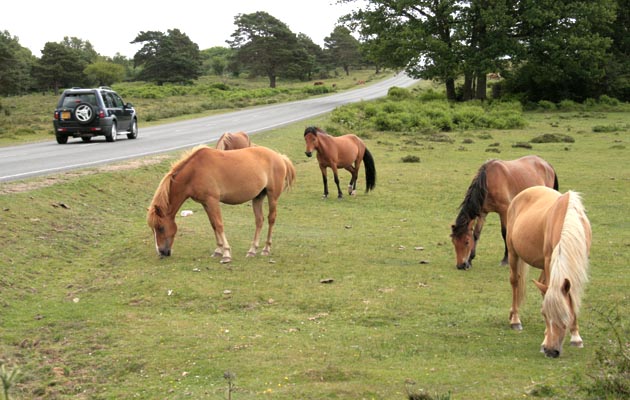Hooftrek founder Graham “Will” Williams offers guided and solo hiking with Welsh mountain pack ponies
We have 16 ponies and three generations of foals that we have bought from the farmers here in Powys who own the feral herds on the hills. The farmers know which ponies belong to which of them. The ponies are all 12hh and will never be ridden; even the 20- to 25-year-olds have had nothing done to them until they come to us and we socialise them.
The best way is to bring the foals in with the grown-ups that know what to do, and they learn from them. Once they see other ponies having headcollars put on and their feet being picked up, they relax. They’re very biddable.
It’s a slow process, from resting a halter over them and brushing them with a pole to get them used to being touched. They’re part of a herd, and they learn their place in it and who’s in charge. There is always a pony in charge of the group to whom they all defer.
{"content":"PHA+VGhlaXIgbnVtYmVycyBhcmUgZGVjbGluaW5nOiB0aGVyZSBhcmUgY3VycmVudGx5IGZld2VyIHRoYW4gNTAwIGJyZWVkaW5nIG1hcmVzIGFjcm9zcyBXYWxlcy4gVGhleeKAmXJlIG5vdCB3b3J0aCBhbnl0aGluZyBpZiB5b3XigJlyZSBub3QgYnJlZWRpbmcgZnJvbSB0aGVtLiBJZiB0aGV5IGhhdmUgYSBwdXJwb3NlLCBwZW9wbGUgd2lsbCBjb250aW51ZSB0byBicmVlZCDigJMgaWYgdGhleSBjYW4gc2VsbCB0aGVtLiBXZSB3YW50IHRvIGZpbmQgYSBwdXJwb3NlIGZvciB0aGVzZSBwb25pZXMuIEl04oCZcyBhbHJlYWR5IGJlZW4gZG9uZSBpbiBFdXJvcGU7IGl04oCZcyBiaWcgYnVzaW5lc3MgaW4gRnJhbmNlLCBJdGFseSwgUG9ydHVnYWwgYW5kIE1vcm9jY28sIHdoZXJlIGRvbmtleXMgdGhhdCB3ZXJlIGZhcm0gYW5pbWFscyBhcmUgbm93IGFuIGltcG9ydGFudCBwYXJ0IG9mIHRoZSBsZWlzdXJlIGluZHVzdHJ5IGFzIHBhY2sgYW5pbWFscy48L3A+CjxwPkhpa2luZyBndWVzdHMgc3RhcnQgYnkgc3BlbmRpbmcgdGltZSB3aXRoIHRoZSBwb25pZXM7IGZlZWRpbmcsIGdyb29taW5nLCBhbmQgcGFja2luZyBraXQgZm9yIG92ZXJuaWdodHMgb3IgcGFubmllcnMgZm9yIHRoZSBkYXkuIElmIHRoZXnigJlyZSBjb25maWRlbnQgaG9yc2UgcGVvcGxlLCB0aGV5IGdvIG9uIHRoZWlyIG93biB3aXRoIG91ciBkZXRhaWxlZCBtYXBzLCByb3V0ZSBkZXNjcmlwdGlvbnMgYW5kIGNhbXBzaXRlIGluZm9ybWF0aW9uLiBHdWlkZWQgb3IgdW5ndWlkZWQsIGV2ZXJ5b25lIGxvb2tzIGFmdGVyIHRoZWlyIG93biBwb255LjwvcD4KPHA+PGRpdiBjbGFzcz0iYWQtY29udGFpbmVyIGFkLWNvbnRhaW5lci0tbW9iaWxlIj48ZGl2IGlkPSJwb3N0LWlubGluZS0yIiBjbGFzcz0iaXBjLWFkdmVydCI+PC9kaXY+PC9kaXY+PHNlY3Rpb24gaWQ9ImVtYmVkX2NvZGUtMzEiIGNsYXNzPSJoaWRkZW4tbWQgaGlkZGVuLWxnIHMtY29udGFpbmVyIHN0aWNreS1hbmNob3IgaGlkZS13aWRnZXQtdGl0bGUgd2lkZ2V0X2VtYmVkX2NvZGUgcHJlbWl1bV9pbmxpbmVfMiI+PHNlY3Rpb24gY2xhc3M9InMtY29udGFpbmVyIGxpc3RpbmctLXNpbmdsZSBsaXN0aW5nLS1zaW5nbGUtc2hhcmV0aHJvdWdoIGltYWdlLWFzcGVjdC1sYW5kc2NhcGUgZGVmYXVsdCBzaGFyZXRocm91Z2gtYWQgc2hhcmV0aHJvdWdoLWFkLWhpZGRlbiI+DQogIDxkaXYgY2xhc3M9InMtY29udGFpbmVyX19pbm5lciI+DQogICAgPHVsPg0KICAgICAgPGxpIGlkPSJuYXRpdmUtY29udGVudC1tb2JpbGUiIGNsYXNzPSJsaXN0aW5nLWl0ZW0iPg0KICAgICAgPC9saT4NCiAgICA8L3VsPg0KICA8L2Rpdj4NCjwvc2VjdGlvbj48L3NlY3Rpb24+PC9wPgo8cD5Zb3UgY2Fu4oCZdCBnbyBmYXIgbGVhZGluZyBwYWNrIHBvbmllcy4gWW91IHRyYXZlbCBzbG93bHk6IDJtcGgsIGlmIHRoYXQuIFRoZSBsb2NhbCByb3V0ZXMgYXJlIGZvciB0d28gdG8gZm91ciBkYXlzIGFuZCB3ZeKAmXJlIHBsYW5uaW5nIGEgMTAtZGF5IHJvdXRlIHRvIHRoZSBjb2FzdC48L3A+CjxwPknigJl2ZSBiZWVuIGhlcmUgZm9yIDMwIHllYXJzOyBJIGZvdW5kZWQgRnJlZXJlaW4gaW4gMTk4OSB3aGljaCByZW1haW5zIHRoZSBvbmx5IHJpZGluZyBjZW50cmUgdG8gb2ZmZXIgdW5lc2NvcnRlZCB0cmFpbCByaWRlcyBmb3IgYWR1bHRzIHRvIGhpcmUgYSBob3JzZSBhbmQgc2VsZi1ndWlkZS4gV2UgYm9vayB0aGVpciBzdGF5cyBpbiBmYXJtcyBhbmQgaW5ucy48L3A+CjxwPlRoZXkgdGFrZSBvdXIgbWFwcyBvbiB0aGVpciByaWRlczogd2UgaGF2ZSBkcmF3biB1cCBkZXRhaWxzIG9mIDgwMCBtaWxlcyBvZiB0cmFpbHMsIGZyb20gdGhlIFd5ZSBWYWxsZXkgYWNyb3NzIHRoZSBSYWRub3IgSGlsbCBhbmQgQ2FtYnJpYW4gTW91bnRhaW5zLjwvcD4KPGRpdiBjbGFzcz0iYWQtY29udGFpbmVyIGFkLWNvbnRhaW5lci0tbW9iaWxlIj48ZGl2IGlkPSJwb3N0LWlubGluZS0zIiBjbGFzcz0iaXBjLWFkdmVydCI+PC9kaXY+PC9kaXY+CjxwPldlIHByYWN0aXNlIG5hdHVyYWwgaG9yc2VtYW5zaGlwLCB3aGljaCBpcyByZWFsbHkganVzdCBiZWluZyBnZW50bGUgd2l0aCB0aGUgcG9uaWVzLjwvcD4KPHA+U29tZSByaWRpbmcgc2Nob29scyBsaWtlIGhvcnNlcyBub3QgdG8gdGhpbms7IHRoZXnigJlkIHJhdGhlciBoYXZlIHRoZW0gb2JlZGllbnQsIGJ1dCB0aGV5IHNob3VsZCBhbGwgbG9vayBvdXQgZm9yIHRoZWlyIHJpZGVycy48L3A+CjxkaXYgY2xhc3M9ImFkLWNvbnRhaW5lciBhZC1jb250YWluZXItLW1vYmlsZSI+PGRpdiBpZD0icG9zdC1pbmxpbmUtNCIgY2xhc3M9ImlwYy1hZHZlcnQiPjwvZGl2PjwvZGl2Pgo8cD5JIGRvbuKAmXQgd2FudCB0aGVtIHN1cGVyLXRyYWluZWQsIHRoZXkgbmVlZCB0byB3b3JrIG91dCB3aGljaCB3YXkgYXJvdW5kIGEgcHVkZGxlLCB0aGV5IHNob3VsZCBrbm93IHdoYXTigJlzIGdvaW5nIG9uIGFuZCBiZSB0aGVyZSBpbiB0aGUgbW9ybmluZyByZWFkeSB0byBzdGFydCB3b3JrLiBJIGRvbuKAmXQgbGlrZSB0byBzZWUgdGhlbSBib290LWNhbXBlZCwgSSBsaWtlIHRvIHNlZSB0aGVtIGtlZW4gdG8gZG8gd2hhdCB0aGV5IGRvLjwvcD4KPGRpdiBjbGFzcz0iYWQtY29udGFpbmVyIGFkLWNvbnRhaW5lci0tbW9iaWxlIj48ZGl2IGlkPSJwb3N0LWlubGluZS01IiBjbGFzcz0iaXBjLWFkdmVydCI+PC9kaXY+PC9kaXY+CjxwPldlIGFyZSB3ZWxsIGtpdHRlZCBvdXQgZm9yIER1a2Ugb2YgRWRpbmJ1cmdoIGV4cGVkaXRpb25zLCBzY2hvb2wgZ3JvdXBzIGFuZCBpbmRpdmlkdWFscy4gQSB3b21hbiB3aG8gd2FzIGlsbCB3aXRoIE1FIHN0YXllZCBoZXJlIGZvciAxOCBtb250aHMuIFRoZSBwb25pZXMga25ldyB3aGVuIHNoZSB3YXMgaWxsIGFuZCBjb3VsZG7igJl0IGNvcGUuIFNoZSBnb3Qgc28gbXVjaCBvdXQgb2YgdGhlbSwgYW5kIGlzIGJldHRlciBub3cuIEphY2tvLCB0aGUgaGVyZCBsZWFkZXIsIHdvdWxkIHN0YW5kIGZvciBob3VycyByZXN0aW5nIG9uIGhlciB3aGVuIHNoZSB3YXMgdXBzZXQuIEJ1dCBvbmNlIHNoZSB3YXMgYmV0dGVyLCBoZSB3b3VsZG7igJl0IGxldCBoZXIgY2F0Y2ggaGltLiBTaGUgdG9vayBpdCBxdWl0ZSBwZXJzb25hbGx5ITwvcD4KPHA+SSBmZWVsIHZlcnkgbXVjaCBsaWtlIEkgbmVlZCBwb25pZXMgYXJvdW5kLiBXZSBkaWQgcGFydCB3YXlzIGZvciBhIHllYXIgd2hlbiBJIGJvdWdodCBzb21lIENhbmFkaWFuIGNhbm9lcyB0byBoaXJlIG91dCBmb3Iga2F5YWtpbmcgdHJpcHMgYW5kIGNhcnJ5aW5nIGNhbXBpbmcgZXF1aXBtZW50LiBCdXQgeW91IGNhbuKAmXQgc3Ryb2tlIHRoZW0gb3IgZ3Jvb20gdGhlbSwgdGhleSBjYW7igJl0IGRvIG11Y2ggKHRob3VnaCB5b3UgZG9u4oCZdCBoYXZlIHRvIGZpbmQgZ3JhemluZyEpIGFuZCBJIG1pc3NlZCBwb25pZXMuPC9wPgo8ZGl2IGNsYXNzPSJpbmplY3Rpb24iPjwvZGl2Pgo8cD5XaGVuIEkgd2FzIGd1aWRpbmcgSSBoYWQgYSAxNGhoIHBvbnkg4oCTIGlkZWFsIGZvciBob3BwaW5nIG9uIGFuZCBvZmYg4oCTIGhlIHdhcyB2ZXJ5IGdvb2QgYXQgZXZlcnl0aGluZyBoZSBoYWQgdG8gZG8uIEkgd2FzIGZvbmQgb2YgaGltLiBCdXQgdGhlcmUgd2FzIHNvbWV0aGluZyBhYm91dCBoaW07IHlvdSBjb3VsZCB0ZWxsIGhl4oCZZCBoYXZlIGxpa2VkIHRvIGhhdmUgbGl2ZWQgb24gdGhlIGhpbGwuPC9wPgo8cD48ZW0+QWxzbyBwdWJsaXNoZWQgaW4gSCZhbXA7SCA0IE1hcmNoIDIwMjE8L2VtPjwvcD4KPHA+Cg=="}
You may also be interested in…
Credit: Nico Morgan Photography
Martha, Lady Sitwell, on 10 years of hunting sideways — and why you’ll never see her in a pair of
Callum Whittle on keeping history alive in a small Wiltshire town by delivering beer using a horse-drawn dray
Lyndsey Stride on catching wily ponies, keeping up the breed’s quality and the joy of seeing the next generation emerge
Credit: ZSL Whipsnade
Mark Holden, head of the large hoofstock team at ZSL Whipsnade Zoo, on the birth of a rare wild foal
H&H features editor
Martha is an experienced journalist who is mad-keen on horses and dogs. Her reporting CV includes the Paris Olympics, European championships, Aachen World Equestrian Festival and World Cup finals. After growing up with assorted liver and white springer spaniels, she enjoyed 14 years with two rescue dogs. Now, her constant companion is Fidget, an extremely energetic and habitually muddy black and white springer. Martha has written on topics as diverse as a top horse’s clone to the best GPS trackers for dogs, as well as equestrian and rural matters for Country Life, The Field, The Times, The Spectator and The Telegraph alongside Horse & Hound .





